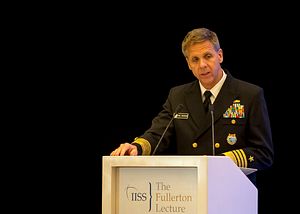Last week, the Associated Press ran a story with the following headline: “U.S. commander hints that quad grouping may be shelved.” The “quad” refers to the informal consultative arrangement that was reconvened in November 2017 between the United States, Japan, Australia, and India, after a decade-long hiatus. It remains very much active and the comments last week — made by Indo-Pacific Commander Adm. Philip Davidson — were taken out of context.
A day after that report, Lt. Col Dave Eastburn, a spokesperson for the U.S. Department of Defense, clarified as much, noting that Davidson “was referring to a formal, regular meeting of military leaders from the four countries.” Diplomatic consultations — the bulk of the quad’s post-November 2017 activity — remain in place and are expected to continue.
Davidson’s remarks were made in Singapore, where he addressed the International Institute for Strategic Studies in a lecture. He did not explicitly address U.S.-Japan-Australia-India quadrilateral cooperation in that lecture, but was asked about it in a separate conversation with reporters.
Davidson, referring to the issue of formalized naval cooperation, noted that the issue had come up “several times.” He attributed a view to Indian Chief of Naval Staff Adm. Sunil Lanba, who “made it quite clear that there wasn’t an immediate potential for a quad.”
“That does not omit or prevent our ability to cooperate in crisis and conflict. And we continue collectively, all of us, to seek opportunities in which we might exercise and work together moving forward,” Davidson added.
India has expressed hesitation in recent years, for instance, to quadrilateralize the Malabar naval exercise, which was originally conceived of as a bilateral U.S.-India event and trilateralized in 2015 to include Japan. That Lanba saw little “immediate” potential is unsurprising in this context.
Indeed, the “quad” is far from anything resembling a military alliance at this point and doesn’t appear to be heading in that direction. The initial November 2017 consultations provided an opportunity for the four participating countries — each of whom happens to be a major Indo-Pacific democracy — to underscore their interests in the region.
The “quad” draws outsized interest, in effect, because of its participants. In reality, the quadrilateral-level engagement between these countries occurs at a relatively low level and the real interesting coordination and security networking between the four is happening within the bilateral and trilateral arrangements between them.
For instance, in addition to the trilateralization of Malabar in 2015, Japan and Australia have acknowledged at the ministerial-level an interest in improving trilateral coordination with India. The United States, India, and Japan have, for the first-time, held a leader-level trilateral meeting on the sidelines of the 2018 G20 meeting in Buenos Aires.
Quadrilateral military coordination and activities, as Davidson noted, aren’t immediately in the cards. In its current state, the quadrilateral consultations between Washington, Tokyo, Delhi, and Canberra are laying the political groundwork for potential growth over the next decades.
The impetus for the original “quad” goes back to Japanese Prime Minister Shinzo Abe’s first nonconsecutive prime ministerial term from 2006-2007. The initiative came to an end in its original configuration after China protested at what it saw as a coalition designed to contain its rise. Hesitations in India and Australia at the time — combined with Abe’s departure from office after just one year — led to an evaporation of interest among the four countries, too.

































